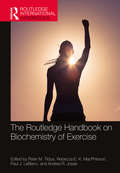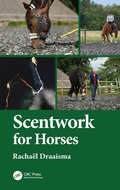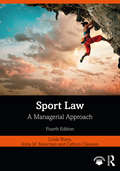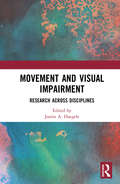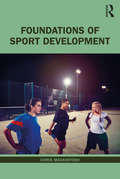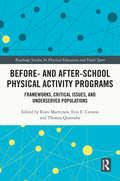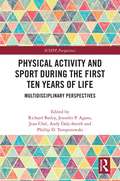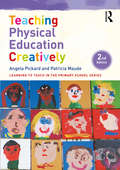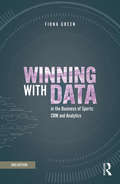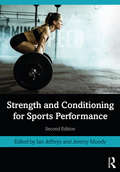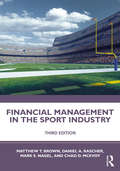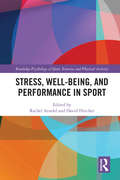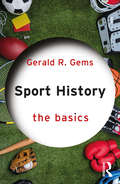- Table View
- List View
The Routledge Handbook on Biochemistry of Exercise (Routledge International Handbooks)
by Peter M. Tiidus Rebecca E. K. MacPherson Paul J. LeBlanc Andrea R. JosseFrom its early beginnings in the 1960s, the academic field of biochemistry of exercise has expanded beyond examining and describing metabolic responses to exercise and adaptations to training to include a wide understanding of molecular biology, cell signalling, interorgan communication, stem cell physiology, and a host of other cellular and biochemical mechanisms regulating acute responses and chronic adaptations related to exercise performance, human health/disease, nutrition, and cellular functioning. The Routledge Handbook on Biochemistry of Exercise is the first book to pull together the full depth and breadth of this subject and to update a rapidly expanding field of study with current issues and controversies and a look forward to future research directions. Bringing together many experts and leading scientists, the book emphasizes the current understanding of the underlying metabolic, cellular, genetic, and cell signalling mechanisms associated with physical activity, exercise, training, and athletic performance as they relate to, interact with, and regulate cellular and muscular adaptations and consequent effects on human health/disease, nutrition and weight control, and human performance. With more emphasis than ever on the need to be physically active and the role that being active plays in our overall health from a whole-body level down to the cell, this book makes an important contribution for scholars, medical practitioners, nutritionists, and coaches/trainers working in research and with a wide range of clients. This text is important reading for all students, scholars, and others with an interest in health, nutrition, and exercise/training in general.
Scentwork for Horses
by Rachaël DraaismaScentwork for Horses is the first practical guide on how to implement scentwork into the lives of domesticated horses, enhancing behaviour, welfare, and the human-animal bond. Scentwork is a new discipline in the field for horse and handler, and expert author Rachaël Draaisma arms the reader with a pallet of information to enable them to put this technique into action. As well as theoretical background information on the nose of the horse and biomechanics, Draaisma discusses how scentwork improves horses’ learning abilities, development, socialisation, and their bond with the handler. Readers will learn how to have their horses explore their environment, participate in scentwork games and follow a footstep track to find a missing person or food bag. Easily accessible for anybody working with horses at any level, scentwork can be done in small areas as well as in larger spaces on various surfaces. Whether veterinarian, behaviourist, trainer, animal-assisted therapist, equine physiotherapist, osteopath, or interested horse owner, this book promises to bring both you and the horse enormous benefits, strengthening the human-animal bond. Rachaël Draaisma has always lived with and had a passion for dogs and horses. In 2002, she decided to make it her profession. Achieving several diplomas, she started to work full time as a trainer and behavioural consultant, first with dogs, later with horses. Her best-selling book Language Signs and Calming Signals of Horses, published by CRC Press in 2017, has been translated into several languages. Another pillar of Draaisma’s working life with horses revolves around equine mental stimulation and scentwork, and she has developed an extensive method to undertake scent tracking with horses, a new tool in enriching the human-equine relationship. Draaisma travels throughout Europe and the globe to provide workshops and lectures on calming signals of horses, equine mental stimulation, and scentwork. You can purchase scent bags to aid your scentwork practice at the author's personal website: www.scentworkforhorses.com or www.calmingsignalsofhorses.com
Scentwork for Horses
by Rachaël DraaismaScentwork for Horses is the first practical guide on how to implement scentwork into the lives of domesticated horses, enhancing behaviour, welfare, and the human-animal bond. Scentwork is a new discipline in the field for horse and handler, and expert author Rachaël Draaisma arms the reader with a pallet of information to enable them to put this technique into action. As well as theoretical background information on the nose of the horse and biomechanics, Draaisma discusses how scentwork improves horses’ learning abilities, development, socialisation, and their bond with the handler. Readers will learn how to have their horses explore their environment, participate in scentwork games and follow a footstep track to find a missing person or food bag. Easily accessible for anybody working with horses at any level, scentwork can be done in small areas as well as in larger spaces on various surfaces. Whether veterinarian, behaviourist, trainer, animal-assisted therapist, equine physiotherapist, osteopath, or interested horse owner, this book promises to bring both you and the horse enormous benefits, strengthening the human-animal bond. Rachaël Draaisma has always lived with and had a passion for dogs and horses. In 2002, she decided to make it her profession. Achieving several diplomas, she started to work full time as a trainer and behavioural consultant, first with dogs, later with horses. Her best-selling book Language Signs and Calming Signals of Horses, published by CRC Press in 2017, has been translated into several languages. Another pillar of Draaisma’s working life with horses revolves around equine mental stimulation and scentwork, and she has developed an extensive method to undertake scent tracking with horses, a new tool in enriching the human-equine relationship. Draaisma travels throughout Europe and the globe to provide workshops and lectures on calming signals of horses, equine mental stimulation, and scentwork. You can purchase scent bags to aid your scentwork practice at the author's personal website: www.scentworkforhorses.com or www.calmingsignalsofhorses.com
Sport Law: A Managerial Approach
by Anita M. MoormanNow in its fourth edition, this text is still the only sport law textbook to introduce sport legal studies from a management perspective and integrate legal strategies to gain a competitive advantage in business. Acknowledging that students understand legal concepts better when they are tied to real sport management practice, the book is organized around the core management functions. It provides concise explanations of key concepts, as well as current industry examples and legal cases, and gives the student all the legal knowledge they need to become confident and effective professionals in sport management, recreation, or sport education. This new edition includes additional contributions from leading sport law educators and practitioners, and has expanded coverage of important contemporary issues including: · Sports injury and concussion litigation· Impact of Covid-19 on events and leagues· Gender discrimination, disability discrimination, sexual harassment, #metoo, and USWNT pay equity· Intellectual property, licensing agreements, publicity rights, social media influencers, and digital privacy· Student-athletes and marketing rights· Sport gambling and state regulation· Athlete activism, employee free speech, and collective bargaining· Olympic and Paralympic restructuring· NCAA Division 1 Coaches Contracts The book contains useful features and ancillaries to help with teaching and learning, including managerial context tables, case opinions, focus cases, strategies for competitive advantage, discussion questions, and learning activities. It is an essential text for any course on sport law or recreation law, an invaluable supplement to any course on sport business and management, and an important reference for all sport management practitioners. Online resources include a variety of exam questions for each chapter, featuring multiple choice, true or false, short answer exam questions and short essay questions, and a sample syllabus.
Sport Law: A Managerial Approach
by Anita M. Moorman Linda Sharp Cathryn ClaussenNow in its fourth edition, this text is still the only sport law textbook to introduce sport legal studies from a management perspective and integrate legal strategies to gain a competitive advantage in business. Acknowledging that students understand legal concepts better when they are tied to real sport management practice, the book is organized around the core management functions. It provides concise explanations of key concepts, as well as current industry examples and legal cases, and gives the student all the legal knowledge they need to become confident and effective professionals in sport management, recreation, or sport education. This new edition includes additional contributions from leading sport law educators and practitioners, and has expanded coverage of important contemporary issues including: · Sports injury and concussion litigation· Impact of Covid-19 on events and leagues· Gender discrimination, disability discrimination, sexual harassment, #metoo, and USWNT pay equity· Intellectual property, licensing agreements, publicity rights, social media influencers, and digital privacy· Student-athletes and marketing rights· Sport gambling and state regulation· Athlete activism, employee free speech, and collective bargaining· Olympic and Paralympic restructuring· NCAA Division 1 Coaches Contracts The book contains useful features and ancillaries to help with teaching and learning, including managerial context tables, case opinions, focus cases, strategies for competitive advantage, discussion questions, and learning activities. It is an essential text for any course on sport law or recreation law, an invaluable supplement to any course on sport business and management, and an important reference for all sport management practitioners. Online resources include a variety of exam questions for each chapter, featuring multiple choice, true or false, short answer exam questions and short essay questions, and a sample syllabus.
Movement and Visual Impairment: Research across Disciplines
by Justin A. HaegeleThis is the first book to offer an in-depth review of research pertaining to individuals with visual impairments across the full span of movement-related disciplines, from biomechanics and motor learning to physical education and Paralympic sport. Each chapter highlights current research trends, future research directions, and practical implications in a key discipline or area of professional practice, drawing on empirical research evidence and opening up new avenues for cross-disciplinary working. Covering physical activity across the life course, from children and young people through to older adults, and addressing the important topic of deafblindness in some depth, the book goes further than any other book published to date on visual impairment and movement. This is essential reading for all advanced students and researchers working in sport, exercise and disability, and an invaluable reference for practitioners and service providers, from in-service teachers and camp directors to physical therapists and physical activity promotion specialists.
Movement and Visual Impairment: Research across Disciplines
by Justin A. HaegeleThis is the first book to offer an in-depth review of research pertaining to individuals with visual impairments across the full span of movement-related disciplines, from biomechanics and motor learning to physical education and Paralympic sport. Each chapter highlights current research trends, future research directions, and practical implications in a key discipline or area of professional practice, drawing on empirical research evidence and opening up new avenues for cross-disciplinary working. Covering physical activity across the life course, from children and young people through to older adults, and addressing the important topic of deafblindness in some depth, the book goes further than any other book published to date on visual impairment and movement. This is essential reading for all advanced students and researchers working in sport, exercise and disability, and an invaluable reference for practitioners and service providers, from in-service teachers and camp directors to physical therapists and physical activity promotion specialists.
Foundations of Sport Development
by Chris MackintoshOffering a complete introduction to sport development policy and practice, this book covers key theory, themes, issues, and debates in sport development, without assuming any prior knowledge on the part of the reader. It outlines the organisational landscape of sport in the UK and explains important differences across England, Scotland, Wales, and Northern Ireland, as well as the global context. Examining both community and elite sport, it covers public, private, and third sectors, including national and local government and national governing bodies, and considers change – cultural, managerial, social, and political – as an element of sport development policy, strategy, and operations. Every chapter includes an in-depth case study around which a seminar or tutorial can be based, as well as definitions of key concepts and terminology that students and practitioners are likely to encounter during their studies or professional practice. Questions at the end of each chapter encourage the reader to reflect on their own work, and useful guides to further reading make the book an ideal jumping off point for further study. This is the perfect foundation textbook for any sport development course taken as part of a degree program in sport development, sport management, or sport coaching.
Foundations of Sport Development
by Chris MackintoshOffering a complete introduction to sport development policy and practice, this book covers key theory, themes, issues, and debates in sport development, without assuming any prior knowledge on the part of the reader. It outlines the organisational landscape of sport in the UK and explains important differences across England, Scotland, Wales, and Northern Ireland, as well as the global context. Examining both community and elite sport, it covers public, private, and third sectors, including national and local government and national governing bodies, and considers change – cultural, managerial, social, and political – as an element of sport development policy, strategy, and operations. Every chapter includes an in-depth case study around which a seminar or tutorial can be based, as well as definitions of key concepts and terminology that students and practitioners are likely to encounter during their studies or professional practice. Questions at the end of each chapter encourage the reader to reflect on their own work, and useful guides to further reading make the book an ideal jumping off point for further study. This is the perfect foundation textbook for any sport development course taken as part of a degree program in sport development, sport management, or sport coaching.
Before and After School Physical Activity Programs: Frameworks, Critical Issues and Underserved Populations (Routledge Studies in Physical Education and Youth Sport)
by Risto Marttinen Erin E. Centeio Thomas QuarmbyThis is the first book to offer a critical examination of the delivery of before and after-school physical activity programs, from global perspectives. It introduces key theory and best practice in before and after-school physical activity research and programming, and is an essential resource for educators involved in the design and implementation of after-school programs. With contributions from leading international researchers and practitioners in the field of health and physical education, the book provides an overview of research methods in before and after-school physical activity. It offers insight on theoretical frameworks and the implementation of programs as they relate to policy in schools, as well as an overview of social and emotional learning in after-school programs. The book also explores inclusive before and after-school physical activity programming for underserved communities, covering key topics from Positive Youth Development and urban programming to developing adult leaders and working with LGBTQI populations and children with disabilities. This book is important reading for researchers in health and physical education, and policy-makers, teachers, youth workers and coaches working with children in physical education, health education, physical activity or sport.
Before and After School Physical Activity Programs: Frameworks, Critical Issues and Underserved Populations (Routledge Studies in Physical Education and Youth Sport)
by Risto Marttinen Erin E. Centeio Thomas QuarmbyThis is the first book to offer a critical examination of the delivery of before and after-school physical activity programs, from global perspectives. It introduces key theory and best practice in before and after-school physical activity research and programming, and is an essential resource for educators involved in the design and implementation of after-school programs. With contributions from leading international researchers and practitioners in the field of health and physical education, the book provides an overview of research methods in before and after-school physical activity. It offers insight on theoretical frameworks and the implementation of programs as they relate to policy in schools, as well as an overview of social and emotional learning in after-school programs. The book also explores inclusive before and after-school physical activity programming for underserved communities, covering key topics from Positive Youth Development and urban programming to developing adult leaders and working with LGBTQI populations and children with disabilities. This book is important reading for researchers in health and physical education, and policy-makers, teachers, youth workers and coaches working with children in physical education, health education, physical activity or sport.
Physical Activity and Sport During the First Ten Years of Life: Multidisciplinary Perspectives (ICSSPE Perspectives)
by Richard Bailey Phillip D. Tomporowski Jean Côté Jennifer P. Agans Andy Daly-SmithEvidence suggests that the first 10 or so years of life create the foundation for subsequent participation in recreational and health-related physical activity. This book brings together researchers and practitioners with expertise in issues related to physical activity, physical education, and sport during the primary/elementary phase of schooling, to explore these important issues. Combining inter-disciplinary perspectives, the book addresses the inherent complexity of researching with young children. It looks at the evidence on development during the first 10 years and how that evidence relates to physical activity and to sport, in pre-school, school and out of school. Finally, the book offers a series of national case studies, from Asia, Europe and Africa, demonstrating the importance of age-appropriate sport and physical activity. This is important reading for any student, researcher, educator or policy maker with an interest in physical activity and health, education in the early years or at primary/elementary level, paediatric exercise science, or youth sport.
Physical Activity and Sport During the First Ten Years of Life: Multidisciplinary Perspectives (ICSSPE Perspectives)
by Bailey RichardEvidence suggests that the first 10 or so years of life create the foundation for subsequent participation in recreational and health-related physical activity. This book brings together researchers and practitioners with expertise in issues related to physical activity, physical education, and sport during the primary/elementary phase of schooling, to explore these important issues. Combining inter-disciplinary perspectives, the book addresses the inherent complexity of researching with young children. It looks at the evidence on development during the first 10 years and how that evidence relates to physical activity and to sport, in pre-school, school and out of school. Finally, the book offers a series of national case studies, from Asia, Europe and Africa, demonstrating the importance of age-appropriate sport and physical activity. This is important reading for any student, researcher, educator or policy maker with an interest in physical activity and health, education in the early years or at primary/elementary level, paediatric exercise science, or youth sport.
Teaching Physical Education Creatively (Learning to Teach in the Primary School Series)
by Angela Pickard Patricia MaudeThis fully updated second edition of Teaching Physical Education Creatively provides knowledge and understanding for students, trainee and qualified teachers, to engage creatively in teaching primary Physical Education. It is full of ideas for developing the teaching of dance, games, gymnastics and ways of using outdoor spaces for activities in an innovative and engaging manner. There is also a chapter to support creative practitioner to plan for creative Physical Education. With an emphasis on developing creative teaching processes by building from children’s curiosity, imagination and need to explore and move, it forges clear links between research and practice, and offers suggestions for developing exciting, engaging new approaches to teaching Physical Education. Key topics explored include: Physical Education and creativity Building physical competence and physical literacy Creative ways to develop the teaching of dance, games, gymnastics and ways of using outdoor spaces for activities Developing understanding of space, speed and dynamics Creative planning Inclusive approaches and aspects of differentiation Teaching Physical Education Creatively presents the theory and background necessary to develop a comprehensive understanding of creative teaching and children’s learning. Packed with practical guidance and inspiration for lively, enjoyable Physical Education, it is an invaluable resource for undergraduate and postgraduate students in initial teacher training, practicing teachers, and undergraduate students of Physical Education and dance.
Teaching Physical Education Creatively (Learning to Teach in the Primary School Series)
by Angela Pickard Patricia MaudeThis fully updated second edition of Teaching Physical Education Creatively provides knowledge and understanding for students, trainee and qualified teachers, to engage creatively in teaching primary Physical Education. It is full of ideas for developing the teaching of dance, games, gymnastics and ways of using outdoor spaces for activities in an innovative and engaging manner. There is also a chapter to support creative practitioner to plan for creative Physical Education. With an emphasis on developing creative teaching processes by building from children’s curiosity, imagination and need to explore and move, it forges clear links between research and practice, and offers suggestions for developing exciting, engaging new approaches to teaching Physical Education. Key topics explored include: Physical Education and creativity Building physical competence and physical literacy Creative ways to develop the teaching of dance, games, gymnastics and ways of using outdoor spaces for activities Developing understanding of space, speed and dynamics Creative planning Inclusive approaches and aspects of differentiation Teaching Physical Education Creatively presents the theory and background necessary to develop a comprehensive understanding of creative teaching and children’s learning. Packed with practical guidance and inspiration for lively, enjoyable Physical Education, it is an invaluable resource for undergraduate and postgraduate students in initial teacher training, practicing teachers, and undergraduate students of Physical Education and dance.
Winning with Data in the Business of Sports: CRM and Analytics
by Fiona GreenNew technologies mean that sports clubs and governing bodies are generating more data than ever to help manage their relationship with fans, their performance, and their income streams. This new edition of Winning with Data in the Business of Sports explains how to acquire, store, maintain, and use data in the most effective ways. The key developments are three-fold: new technology, new understanding of how to apply that technology, and the new laws informing and controlling the data that can be generated from the technology. Important developments that have occurred since the publication of the first edition include the General Data Protection Regulations (GDPR) and the COVID-19 pandemic. With a focus on these unique challenges coupled with the opportunities the use of data creates, this book is essential reading for professionals within the sports industry. This second edition includes: - An introduction to new technologies, the data they generate, and the supporting processes we need to have in place to use them. - Brand new case studies with recent examples of creative applications from clubs, teams, leagues, and governing bodies, including Arsenal, AS Roma, ICC Cricket World Cup, LA Kings, Portland Trail Blazers, and UEFA. - The sports industry’s response to tighter data legislation introduced primarily though the GDPR. - The role of data and direct engagement during the COVID-19 pandemic. The book provides clear guidance and knowledge that sports industry professionals need to understand the role of data for the business side of sports. It is essential reading for sports clubs, governing bodies and those working in sports marketing, media and communications, sponsorship, merchandise, ticketing, events, and participation development. The book will also be of interest to students of sports management.
Winning with Data in the Business of Sports: CRM and Analytics
by Fiona GreenNew technologies mean that sports clubs and governing bodies are generating more data than ever to help manage their relationship with fans, their performance, and their income streams. This new edition of Winning with Data in the Business of Sports explains how to acquire, store, maintain, and use data in the most effective ways. The key developments are three-fold: new technology, new understanding of how to apply that technology, and the new laws informing and controlling the data that can be generated from the technology. Important developments that have occurred since the publication of the first edition include the General Data Protection Regulations (GDPR) and the COVID-19 pandemic. With a focus on these unique challenges coupled with the opportunities the use of data creates, this book is essential reading for professionals within the sports industry. This second edition includes: - An introduction to new technologies, the data they generate, and the supporting processes we need to have in place to use them. - Brand new case studies with recent examples of creative applications from clubs, teams, leagues, and governing bodies, including Arsenal, AS Roma, ICC Cricket World Cup, LA Kings, Portland Trail Blazers, and UEFA. - The sports industry’s response to tighter data legislation introduced primarily though the GDPR. - The role of data and direct engagement during the COVID-19 pandemic. The book provides clear guidance and knowledge that sports industry professionals need to understand the role of data for the business side of sports. It is essential reading for sports clubs, governing bodies and those working in sports marketing, media and communications, sponsorship, merchandise, ticketing, events, and participation development. The book will also be of interest to students of sports management.
Strength and Conditioning for Sports Performance
by Ian Jeffreys Jeremy MoodyAn effective strength and conditioning program is an essential component of the preparation of any athlete or sportsperson. Strength and Conditioning for Sports Performance is a comprehensive and authoritative introduction to the theory and practice of strength and conditioning, providing students, coaches and athletes with everything they need to design and implement effective training programs. Revised and updated for a second edition, the book continues to include clear and rigorous explanations of the core science underpinning strength and conditioning techniques and give detailed, step-by-step guides to all key training methodologies, including training for strength, speed, endurance, flexibility and plyometrics. The second edition expands on the opening coaching section as well as introducing an entirely new section on current training methods which includes examining skill acquisition and motor learning. Throughout the book the focus is on the coaching process, with every chapter highlighting the application of strength and conditioning techniques in everyday coaching situations. Strength and Conditioning for Sports Performance includes a unique and extensive section of sport-specific chapters, each of which examines in detail the application of strength and conditioning to a particular sport, from soccer and basketball to golf and track and field athletics. The second edition sees this section expanded to include other sports such as rugby union, rugby league and American football. The book includes contributions from world-leading strength and conditioning specialists, including coaches who have worked with Olympic gold medallists and international sports teams at the highest level. Strength and Conditioning for Sports Performance is an essential course text for any degree-level student with an interest in strength and conditioning, for all students looking to achieve professional accreditation, and an invaluable reference for all practising strength and conditioning coaches.
Strength and Conditioning for Sports Performance
by Ian Jeffreys and Jeremy MoodyAn effective strength and conditioning program is an essential component of the preparation of any athlete or sportsperson. Strength and Conditioning for Sports Performance is a comprehensive and authoritative introduction to the theory and practice of strength and conditioning, providing students, coaches and athletes with everything they need to design and implement effective training programs. Revised and updated for a second edition, the book continues to include clear and rigorous explanations of the core science underpinning strength and conditioning techniques and give detailed, step-by-step guides to all key training methodologies, including training for strength, speed, endurance, flexibility and plyometrics. The second edition expands on the opening coaching section as well as introducing an entirely new section on current training methods which includes examining skill acquisition and motor learning. Throughout the book the focus is on the coaching process, with every chapter highlighting the application of strength and conditioning techniques in everyday coaching situations. Strength and Conditioning for Sports Performance includes a unique and extensive section of sport-specific chapters, each of which examines in detail the application of strength and conditioning to a particular sport, from soccer and basketball to golf and track and field athletics. The second edition sees this section expanded to include other sports such as rugby union, rugby league and American football. The book includes contributions from world-leading strength and conditioning specialists, including coaches who have worked with Olympic gold medallists and international sports teams at the highest level. Strength and Conditioning for Sports Performance is an essential course text for any degree-level student with an interest in strength and conditioning, for all students looking to achieve professional accreditation, and an invaluable reference for all practising strength and conditioning coaches.
Financial Management in the Sport Industry
by Matthew T. Brown Daniel A. Rascher Mark S. Nagel Chad D. McEvoyNow in a fully revised and updated third edition, this essential textbook introduces the fundamentals of sport finance and sound financial management in the sport industry. It is still the only textbook to explain every aspect of finance from the perspective of the sport management practitioner, explaining key concepts and showing how to apply them in practice in the context of sport. The text begins by covering finance basics and the tools and techniques of financial quantification, using industry examples to apply the principles of financial management to sport. It then goes further, to show how financial management works specifically in the sport industry. Discussions include interpreting financial statements, debt and equity financing, capital budgeting, facility financing, economic impact, risk and return, time value of money, and more. The final part of the book examines financial management in four sectors of the industry: public sector sport, collegiate athletics, professional sport, and international sport. It provides an in-depth analysis of the mechanics of financial management within each of these sport sectors. Useful features, such as sidebars, concept checks, practice problems, case analysis and case questions will help students engage more deeply with financial techniques and encourage problem-solving skills. This new edition includes a completely new chapter on international sport, reflecting the globalized nature of the modern sport industry, as well expanded coverage of current issues such as digital media finance, recent legal cases affecting collegiate sport, and the central importance of collective bargaining. Financial Management in the Sport Industry is an essential textbook for any undergraduate or postgraduate course in sport finance, and an invaluable supplement to any course in sport business or sport management. It is also an important reference for all sport management practitioners looking to improve their understanding of finance. The book is accompanied by updated and expanded ancillary materials, including an instructor’s manual, PowerPoint slides, and an image bank.
Financial Management in the Sport Industry
by Matthew T. Brown Daniel A. Rascher Mark S. Nagel Chad D. McEvoyNow in a fully revised and updated third edition, this essential textbook introduces the fundamentals of sport finance and sound financial management in the sport industry. It is still the only textbook to explain every aspect of finance from the perspective of the sport management practitioner, explaining key concepts and showing how to apply them in practice in the context of sport. The text begins by covering finance basics and the tools and techniques of financial quantification, using industry examples to apply the principles of financial management to sport. It then goes further, to show how financial management works specifically in the sport industry. Discussions include interpreting financial statements, debt and equity financing, capital budgeting, facility financing, economic impact, risk and return, time value of money, and more. The final part of the book examines financial management in four sectors of the industry: public sector sport, collegiate athletics, professional sport, and international sport. It provides an in-depth analysis of the mechanics of financial management within each of these sport sectors. Useful features, such as sidebars, concept checks, practice problems, case analysis and case questions will help students engage more deeply with financial techniques and encourage problem-solving skills. This new edition includes a completely new chapter on international sport, reflecting the globalized nature of the modern sport industry, as well expanded coverage of current issues such as digital media finance, recent legal cases affecting collegiate sport, and the central importance of collective bargaining. Financial Management in the Sport Industry is an essential textbook for any undergraduate or postgraduate course in sport finance, and an invaluable supplement to any course in sport business or sport management. It is also an important reference for all sport management practitioners looking to improve their understanding of finance. The book is accompanied by updated and expanded ancillary materials, including an instructor’s manual, PowerPoint slides, and an image bank.
Stress, Well-Being, and Performance in Sport (Routledge Psychology of Sport, Exercise and Physical Activity)
by Rachel Arnold David FletcherStress, Well-Being, and Performance in Sport provides the first comprehensive and contemporary overview of stress in sport and its implications on performance and well-being. It explores how athletes’, coaches, and support staff’s performance can be enhanced while simultaneously optimizing their well-being in contemporary sport. Divided into four sections following the stress process, Stress, Well-Being, and Performance in Sport covers key topics including: Appraising and Coping with Stress in Sport Responses to and Outcomes of Stress in Sport Moderators of the Stress Process in Sport Stress management to Promote Thriving in Sport Bringing together theory and practice, each chapter discusses conceptual and theoretical issues, current research, and innovative practical implications. Written by scholars around the globe, Stress, Well-being, and Performance offers an international perspective. It is important reading for students, professionals working in the field of sport psychology, as well as coaches, athletes, and support staff.
Stress, Well-Being, and Performance in Sport (Routledge Psychology of Sport, Exercise and Physical Activity)
by Rachel Arnold David FletcherStress, Well-Being, and Performance in Sport provides the first comprehensive and contemporary overview of stress in sport and its implications on performance and well-being. It explores how athletes’, coaches, and support staff’s performance can be enhanced while simultaneously optimizing their well-being in contemporary sport. Divided into four sections following the stress process, Stress, Well-Being, and Performance in Sport covers key topics including: Appraising and Coping with Stress in Sport Responses to and Outcomes of Stress in Sport Moderators of the Stress Process in Sport Stress management to Promote Thriving in Sport Bringing together theory and practice, each chapter discusses conceptual and theoretical issues, current research, and innovative practical implications. Written by scholars around the globe, Stress, Well-being, and Performance offers an international perspective. It is important reading for students, professionals working in the field of sport psychology, as well as coaches, athletes, and support staff.
Sport History: The Basics (The Basics)
by Gerald R. GemsThis is a fundamental text for the study of sport history. It answers the ‘why,’ ‘how,’ and ‘what’ questions, introducing the key principles and practices of sport history and walking the reader through the fascinating stories, debates, issues, and national and international narratives that constitute the history of sport. The book provides an overview of the field and the various professional roles assumed by practitioners, such as researchers, academics, and public historians. It is brief, crisp, and to the point. The main general topics of interest within the field – gender, race, nationalism, religion, sport and leisure, and megaevents – are covered with introductory vignettes, stories of interest, a wide variety of theoretical frameworks, and relevant historiography in the most current and timely text of its kind. Each chapter provides a list of further readings for more in-depth study. Students are taught how to conduct research and present their findings in a variety of mediums, and teaching and publication tips are offered for educators. Sport History: The Basics is essential reading for any student on a sport-related degree course or with an interest in social and cultural history. It is also fascinating reading for anybody with a general interest in sport.
Sport History: The Basics (The Basics #8)
by Gerald R. GemsThis is a fundamental text for the study of sport history. It answers the ‘why,’ ‘how,’ and ‘what’ questions, introducing the key principles and practices of sport history and walking the reader through the fascinating stories, debates, issues, and national and international narratives that constitute the history of sport. The book provides an overview of the field and the various professional roles assumed by practitioners, such as researchers, academics, and public historians. It is brief, crisp, and to the point. The main general topics of interest within the field – gender, race, nationalism, religion, sport and leisure, and megaevents – are covered with introductory vignettes, stories of interest, a wide variety of theoretical frameworks, and relevant historiography in the most current and timely text of its kind. Each chapter provides a list of further readings for more in-depth study. Students are taught how to conduct research and present their findings in a variety of mediums, and teaching and publication tips are offered for educators. Sport History: The Basics is essential reading for any student on a sport-related degree course or with an interest in social and cultural history. It is also fascinating reading for anybody with a general interest in sport.
